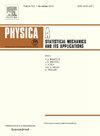Traffic safety evaluation for mixed traffic flow caused by degradation of connected automated vehicles
IF 2.8
3区 物理与天体物理
Q2 PHYSICS, MULTIDISCIPLINARY
Physica A: Statistical Mechanics and its Applications
Pub Date : 2025-02-01
DOI:10.1016/j.physa.2025.130353
引用次数: 0
Abstract
The mixed traffic flow, characterized by the coexistence of different vehicle types such as human-driven vehicles (HDVs) and connected automated vehicles (CAVs), presents new challenges in terms of traffic safety, particularly due to the degradation effect observed when CAVs follow HDVs. Understanding the traffic risks associated with different car-following modes in mixed traffic flow is essential for ensuring an efficient and safe transportation system. This study aims to assess the traffic risks by considering the heterogeneity of vehicle types and their corresponding car-following behaviors. First, an improved Intelligent driver model (IDM), CACC model, and ACC model are established to describe the driving behaviors of HDVs, normal CAVs (NCAVs), and degraded CAVs (DCAVs), respectively, while considering perception-reaction time (PRT). Second, three kinds of surrogated safety measures of the collision risk, namely time-based indicator, space-based indicator, and deceleration-based indicator, are introduced for quantifying the collision risks on highways. Finally, the impact of PRT, the penetration rate of CAVs, and the platoon intensity on the safety of mixed traffic flow are evaluated based on a numerical simulation. The results indicate that the influence of different car-following modes on the safety of mixed traffic flow is closely related to the PRT of CAVs and the platoon intensity. The stability of mixed traffic flows with DCAVs following HDVs is not superior to that of fully HDVs. When the proportion of DCAVs reaches its maximum, the safety of the platoon is at its worst. Increasing platoon intensity and penetration rate can reduce accident risk, with the effect of penetration rate being more significant than that of platoon intensity.
求助全文
约1分钟内获得全文
求助全文
来源期刊
CiteScore
7.20
自引率
9.10%
发文量
852
审稿时长
6.6 months
期刊介绍:
Physica A: Statistical Mechanics and its Applications
Recognized by the European Physical Society
Physica A publishes research in the field of statistical mechanics and its applications.
Statistical mechanics sets out to explain the behaviour of macroscopic systems by studying the statistical properties of their microscopic constituents.
Applications of the techniques of statistical mechanics are widespread, and include: applications to physical systems such as solids, liquids and gases; applications to chemical and biological systems (colloids, interfaces, complex fluids, polymers and biopolymers, cell physics); and other interdisciplinary applications to for instance biological, economical and sociological systems.

 求助内容:
求助内容: 应助结果提醒方式:
应助结果提醒方式:


